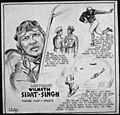Wilmeth Sidat-Singh facts for kids
Quick facts for kids
Wilmeth Sidat-Singh
|
|
|---|---|

Poster from Office for Emergency Management, Office of War Information News Bureau, 1943
|
|
| Nickname(s) | The Syracuse Walking Dream |
| Born | February 13, 1918 Washington, DC |
| Died | May 9, 1943 (aged 25) Lake Huron |
| Allegiance | United States |
| Service/ |
United States Army Air Forces United States Air Force |
| Years of service | 1943 |
Wilmeth Sidat-Singh (born February 13, 1918 – died May 9, 1943) was an amazing American athlete and a brave pilot. He was a talented player in both basketball and football. Later, he became an officer with the Tuskegee Airmen, a special group of African-American pilots. Wilmeth faced unfair rules because of segregation during the 1930s.
Contents
Early Life and Family
Wilmeth Sidat-Singh was born in Washington, DC. His parents were both African-American. After his father, Elias Webb, passed away, his mother, Pauline, married Samuel Sidat-Singh. Samuel was a medical student from India. He adopted Wilmeth, which is how Wilmeth got his last name.
After Dr. Sidat-Singh finished college, the family moved to Harlem in New York City. Wilmeth quickly showed he was a natural athlete. He became a basketball star at DeWitt Clinton High School. In 1934, he led his team to win the New York Public High School Athletic League championship.
Sports Star: Basketball and Football
Wilmeth received a scholarship to play basketball at Syracuse University and started there in 1935. A coach saw him playing football for fun and asked him to join the team. Wilmeth became a star player for Syracuse in both sports. He played a position similar to today's quarterback in football.
Syracuse University was one of the first schools to have African-American players in key positions. However, during that time, many Southern states had strict segregation laws. This meant African-American players from Northern schools were often not allowed to play in games held in the South.
Facing Segregation in Sports
Because Wilmeth had a light skin tone and an Indian last name, some people thought he was from India. This sometimes allowed him to play in games where African-American players were banned.
But before a game against the University of Maryland in 1937, a black sportswriter named Sam Lacy wrote an article. He revealed that Wilmeth Sidat-Singh was African-American. Because of this, Wilmeth was not allowed to play in that game, and Syracuse lost.
The next year, Syracuse played Maryland again. This time, the game was at Syracuse. Wilmeth Sidat-Singh led his team to a huge victory, winning 53-0!
After college, professional sports leagues like the National Basketball League (NBL) and National Football League (NFL) had unofficial bans on black players. So, Wilmeth played for a short time with a professional basketball team in Syracuse. Later, he joined the Metropolitan Police Department of the District of Columbia as an officer.
Military Service and Legacy
When the United States entered World War II, Wilmeth wanted to serve his country. He joined the Tuskegee Airmen. This was a special group of African-American pilots in the U.S. Army Air Force. Wilmeth trained hard and earned his wings as a pilot.
Sadly, Wilmeth Sidat-Singh died in 1943 during a training flight. The engine of his airplane stopped working, and his plane crashed into Saginaw Bay. His parachute got tangled, and he drowned in Lake Huron.
Remembering Wilmeth Sidat-Singh
Wilmeth Sidat-Singh's bravery and talent are still remembered today.
- In 2005, Syracuse University honored him by retiring his basketball jersey number, 19. His jersey now hangs in the Carrier Dome.
- In 2013, the University of Maryland publicly apologized to Wilmeth's family for the unfair treatment he received in 1937. This apology happened during a football game between Syracuse and Maryland.
Images for kids


